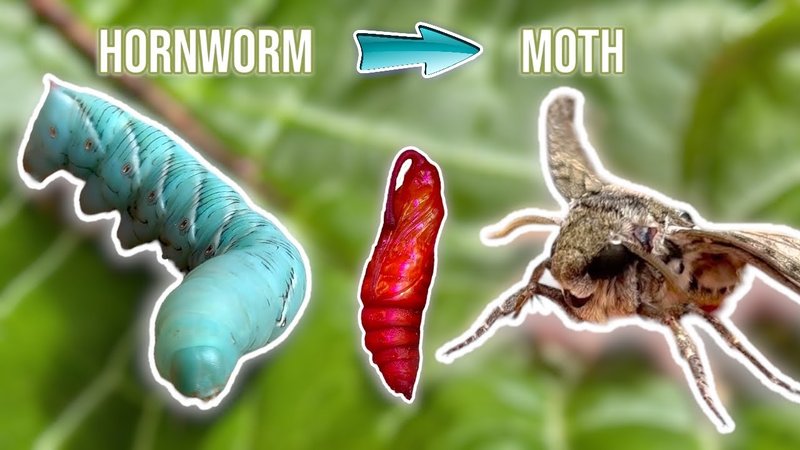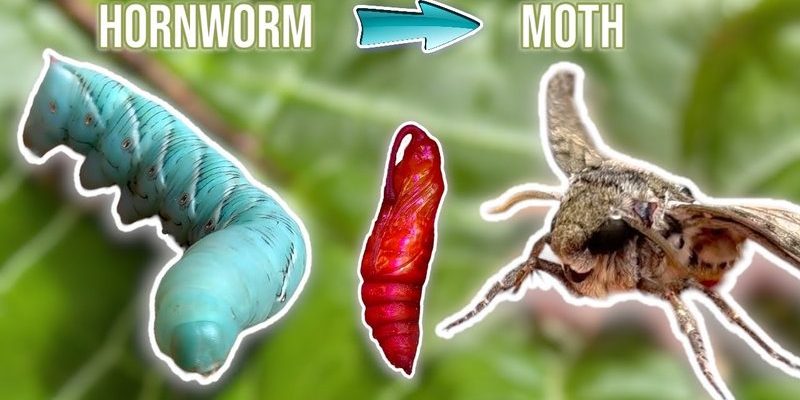
**Hornworms** are the larvae of moths, specifically the hawk moth. You’ve probably seen them on tomato plants or other veggies, and they can be pretty impressive in size. They grow quickly for a reason: they’re on a mission to become moths. If you’re curious about the life cycle of a hornworm and how they develop, you’re in for a treat. Let’s dive into this fascinating world of hornworms and explore their growth journey.
The Life Cycle of Hornworms
Hornworms go through several stages in their life cycle, starting as eggs. These eggs are tiny and often laid on the underside of leaves. When they hatch, they emerge as tiny caterpillars, ready to start munching. Here’s a breakdown of their growth stages:
- Egg Stage: This is where it all begins. The eggs are about the size of a pinhead and can be laid in clusters.
- Lava Stage: Once they hatch, they become the caterpillars we commonly refer to as hornworms. In this stage, they start growing quickly.
- Pupal Stage: After several molts, they’ll form a pupa, where they’ll undergo metamorphosis into a moth.
- Adult Moth: Finally, they emerge as adult moths, ready to continue the cycle.
Each of these stages is crucial for their development, but most of the notable growth happens during the larval stage.
How Long Does It Take for Hornworms to Grow?
Hornworms have a pretty rapid growth rate, especially when you consider their short lifespan of about 3 weeks to a month max. In the larval stage, they can grow from a tiny caterpillar to a hefty 4 to 5 inches long in just **two weeks**!
During their growth, they indulge in plenty of food, which is why you’ll often find them on garden favorites like tomatoes and peppers. They feast day and night, growing quickly and preparing for their next stage. It’s almost like they’re on a mission to bulk up as much as possible before their time runs out. When they start reaching their full size, it’s a sign that they’re getting ready to transform into their final form.
The Ideal Conditions for Hornworm Growth
If you’re wondering how to raise hornworms or keep them in your garden, it’s essential to know what makes them thrive. Here are the ideal conditions for hornworm growth:
- Temperature: Hornworms love warmth. They thrive in temperatures around 70°F to 85°F. If it gets too cold, their growth can slow down.
- Food Supply: These caterpillars are voracious eaters! They particularly enjoy tomatoes, eggplants, and peppers. Ensuring they have a constant food source is key to their rapid growth.
- Moisture: While they don’t need a lot of water, maintaining a slightly humid environment can aid in their growth.
Understanding these conditions will not only help hornworms grow faster but also ensure they reach their full potential.
Why Hornworms Grow Fast: The Science Behind It
You might be wondering, “What makes hornworms grow so quickly?” Essentially, it boils down to survival and evolution. These caterpillars have a short lifespan, and their main goal is to grow, eat, and transform into moths before predators can catch them.
The rapid growth also helps them become less vulnerable to threats. A larger hornworm is less likely to be eaten by birds or other predators. Here’s how it works:
1. **High Metabolism:** Hornworms have a fast metabolism, allowing them to digest their food quickly and put on weight.
2. **Feeding Strategy:** They eat non-stop, especially at night. This helps them make the most of the time they have to grow.
3. **Molting:** They shed their skin several times during their growth, allowing them to expand and accommodate their increasing size.
This combination of traits means that hornworms adapt quickly and efficiently to their environment.
Common Challenges in Hornworm Growth
Despite their rapid growth, hornworms can face some challenges that might slow them down. Here are a few issues that can pop up:
- Pests and Diseases: Just like any other plant, hornworms can fall prey to diseases or parasites that affect their growth.
- Food Shortage: If the supply of preferred plants runs out, they’ll struggle to get enough nutrition.
- Temperature Extremes: Too much heat or cold can halt their growth or even lead to death.
By keeping an eye on these factors, you can help ensure healthy growth if you’re raising hornworms.
What Happens When Hornworms Reach Their Full Size?
Once hornworms hit their max size, they prepare for the next big step: metamorphosis. At this point, they’ll find a safe spot to pupate. This can be in the soil or on a nearby structure.
They’ll now be in a protective shell for a few weeks. This part of their growth is crucial for their transformation into moths. Here’s what to expect:
1. **Pupation:** During this period, they won’t eat at all. Instead, their bodies internally reorganize to develop wings and other adult body parts.
2. **Emergence:** After about a week, they’ll emerge as stunning adult moths, ready to continue the life cycle.
3. **Reproduction:** The adults will soon find mates, continuing the cycle, and the females will lay eggs to start it all over again.
It’s a fascinating journey, from tiny caterpillar to a moth soaring through the skies!
Hornworms are remarkable creatures with a growth process that’s incredibly fast and interesting. From their tiny beginnings to becoming hefty caterpillars in just a few weeks, they’re a testament to the power of nature. Whether you’re gardening and encountering them or considering raising them, understanding their growth helps appreciate their role in the ecosystem.
So, the next time you see a hornworm, maybe take a moment to marvel at how quickly they’re growing, all in the name of survival and transformation!

